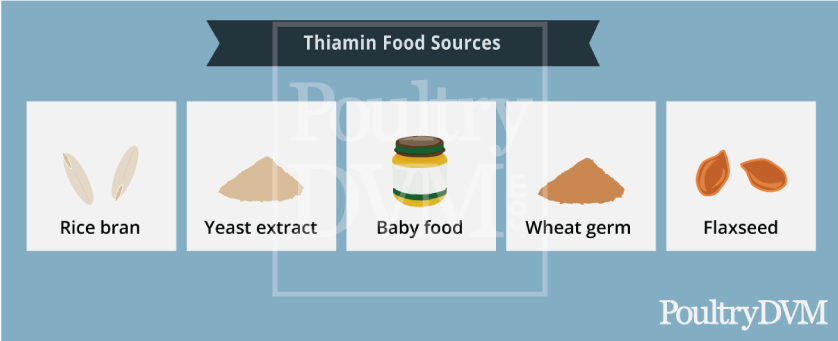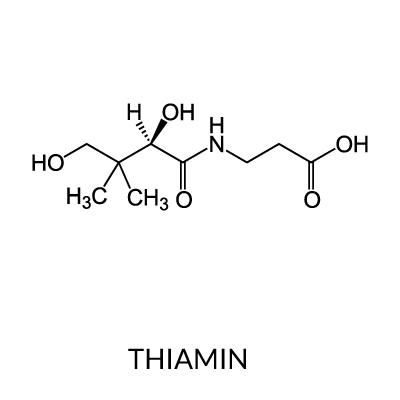Vitamin B1, also called thiamine or thiamin, is one of 8 water-soluble B vitamins.
Like other B-complex vitamins, thiamine is sometimes called an "anti-stress" vitamin because it may strengthen the immune system and improve the body's ability to withstand stressful conditions. Chickens are more susceptible to neuromuscular effects of thiamine deficiency than mammals. Thiamine deficiency affects many systems of the chicken's body, including the muscles, heart, nerves, and digestive system. A principal function of thiamin in all cells is as the coenzyme cocarboxylase or TPP. TPP is essential in reactions that produce energy from glucose or that convert glucose to fat for storage in the tissues. When there is not enough thiamin in the diet, these basic energy functions are disturbed, leading to problems throughout the body.
Clinical signs of thiamine deficiency in chicks are:
- Ataxia
- Tremors, with the severity of the spasms increased when frightened.
- As the deficiency progresses, paralysis of the muscles occurs, beginning with the flexors of the toes and progressing upward, affecting the extensor muscles of the legs, wings and neck.
- Chicks will sit on their flexed legs and draw back their head in a stargazing position, which is often referred to as wry neck. Retraction of the head is due to paralysis of the anterior neck muscles.
- Inability to stand or sit upright
In adult chickens, thiamin deficiency signs include:
- Lethargy
- Head tremors
- General weakness
- Impaired digestion
- Severe loss of appetite. The bird will not resume eating unless given foods containing thiamine.
- Chickens will sit on their flexed legs and draw back their head in a stargazing position, which is often referred to as wry neck. Retraction of the head is due to paralysis of the anterior neck muscles.
- Emaciation
- Frequent convulsions
- High mortality of embryos prior to hatching in eggs produced by deficient parents. Any chicks that do hatch will demonstrate clinical signs of severe thiamine deficiency
Deficient birds can rapidly detect and discriminate against foods that do not provide the vitamin.
Thiamin Dietary Requirements
| Age/Life Stage | mg/kg |
|---|
| Newly Hatched Chicks (0 - 10 wks) | 2-2.5 |
| Young & Growing (10 - 20 wks) | 2-2.5 |
| Laying hens (Actively laying eggs) | 2.5-3 |
| Breeders (20 wks & older)* | 2.5-3.5 |
| Broiler/'Meat' Breed Chicks (0-18 wks) | 2.0-3 |
| Broiler/'Meat' Breeds* (19 wks & older) | 3-3.5 |
| *Includes roosters |
Light breeds (Leghorns) seem to have higher thiamin levels than heavy breeds. As chicken age, the need for thiamin increases because efficiency of vitamin utilization usually diminishes. Thiamin requirements are also influenced by other dietary factors, and increased requirements are associated with chickens receiving:
- High carbohydrate-based diets
- Fishmeal based feed, supplements, or table scraps
- Consuming moldy or spoiled feed
Thiamin Food Sources
The largest food sources of thiamin are Brewer’s yeast. Cereal grains and their by-products, soybean meal, cottonseed meal and peanut meal are relatively rich sources of thiamin.



